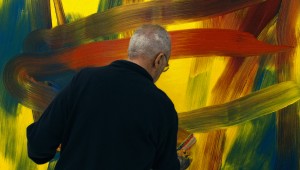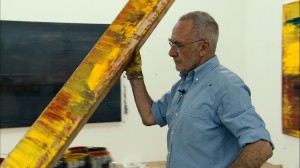‘Gerhard Richter Painting’ looks closer at the world-famous German artist

Gerhard Richter Painting, the new documentary about the famous German abstract artist, follows the man behind the brush with a close eye. We watch Richter bring large canvases from blank nothingness to scattered beauty. All the while, the artist scrutinizes his creations like a detective. When something’s not quite right, he knows it. Standing back a few feet from the large pieces of art, he examines each one, trying to understand their color schemes, their motivations, their reasons for existence.
Much of Richter’s contemplation is internal. He’s a quiet man who doesn’t articulate his artistic wisdom with much eloquence. This makes Corinna Belz’s documentary an interpretive work. Her film doesn’t get at the heart of this influential painter, whose best known for his colorful abstractions, photorealist portraits and political works. Many of the mysteries and motivations behind Richter remain just as elusive when the final credits roll.
However, this doesn’t mean Gerhard Richter Painting is a disappointment. By showing us the process of creation, in a very deliberative, almost meditative, manner, we are able to get closer to understanding the sometimes tortured relationship between a painter and his canvas. Plus, who is kidding who, Richter is a fun artist to watch. He’s not toiling away on a few dots of color. He’s not giving life to assembled fruit or portraits of nobility. His works — at least the ones showcased in the film — are large, expressive and feature layer upon layer of vibrant colors.

When looking at Richter work in his expansive Cologne studio, it almost looks like a child has found his way into a paint store. The first few strokes are quick, broad and even sloppy. The magic is when the German painter begins layering more colors on top of his foundation, and then he takes a large “squeegee” to blend everything together. For some critics, this may seem trivial and not exactly worthy of admiration. But for those with an understanding (or even passing interest) in visual art, the creations are skilled and carefully detailed. Richter is a painter in control of his personal chaos.
Belz’s film follows the artist over the stretch of a few months. We travel with him from major exhibition to major exhibition, places where he is heralded as a modern-day master. The octogenarian obviously enjoys the success of his work, but doesn’t care for the added spotlight. He looks uncomfortable in a crowd of people, and seems to yearn for his studio and vivid paints.
Much of the movie, which is currently playing at New York City’s Film Forum, is silent. Gerhard Richter Painting is a thinking man’s film, an exercise in staying silent and watching the creative process organically unfold. Belz seems to think that if we leave the cameras running long enough, Richter may divulge some of his inner thoughts, some of the reasoning behind his choices.
The camerawork is beautiful, especially in clever sequences where Belz is able to capture Richter’s silhouette in his own paintings. For a film about color, it’s important that everything looks crisp and sharp. Otherwise, the process of watching a white canvas change over into something we’ve never seen before would feel regular and ordinary.
Gerhard Richter Painting thankfully allows us to see the skill behind the skilled artist, even if many questions continue to linger.
By John Soltes / Publisher / John@HollywoodSoapbox.com



